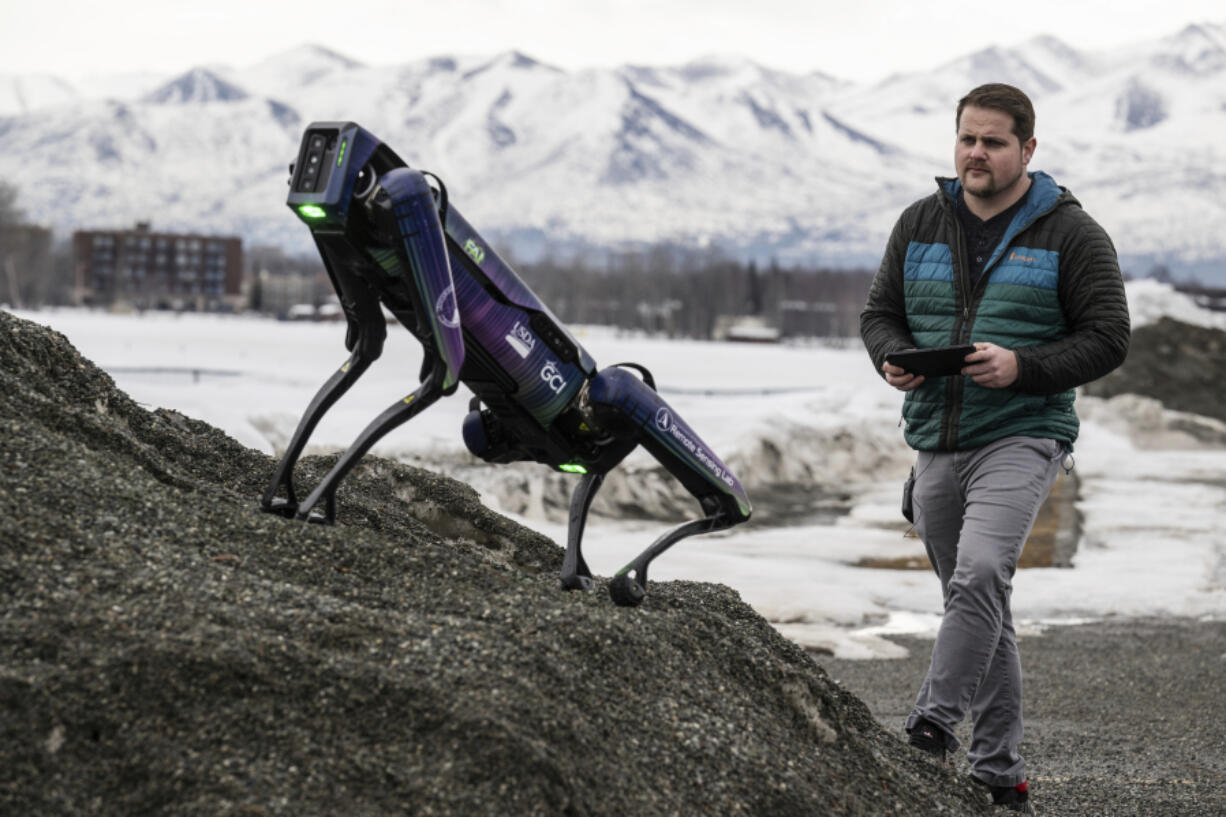ANCHORAGE, Alaska — A doglike robot that recently drew notice in the state Capitol and on social media is being tested to spook wildlife at Fairbanks International Airport while disguised as a coyote or fox, a state agency said.
The Alaska Department of Transportation and Public Facilities on Friday posted a short video on Instagram of the robo-dog. The agency named it Aurora, calling it the department’s “new hire.”
The department explained in a caption that the robot would be based out of the Fairbanks airport, where it would “enhance & augment airport safety and operations.”
In the video, a headless, insect-like robot roughly the size of a large dog with a colorful exterior scrambles over rocks, climbs stairs and appears to dance, flashing green lights.
Not everyone who saw the post was a fan.
“We DO NOT want to see surveillance robot dogs here, even if they are chrome colored,” one user commented.
“I’ve seen this episode of Black Mirror,” another wrote, referencing a dystopian science fiction show that explores humanity’s relationship with technology. “It doesn’t end well.”
The use of robots by government agencies has become more common but also has led to skepticism and controversy. New York City’s police department recently retired a 400-pound robot the agency had planned to use as a roving surveillance camera in the Times Square subway station, sparking many questions from privacy rights advocates. Portland police last year rolled out an autonomous security robot for street surveillance. And the Anchorage Police Department has a robot it uses as part of its bomb squad.
In Alaska, remote technology is being used more broadly by state agencies to monitor earthquake and avalanche damage and road conditions, to respond more quickly to natural disasters, and to aid in search and rescue efforts, according to Ryan Marlow, a program manager with the Alaska Department of Transportation.
The Alaska Department of Public Safety has no plans to use robots as a surveillance or more general public safety tool in Alaska, agency spokesperson Austin McDaniel said.
Law enforcement agencies in the state currently use small drones or robots to help disable bombs and assist with search and rescue missions, but the Department of Public Safety has no plans to implement autonomous robots for other uses, McDaniel said.
The Alaska transportation department’s robotic dog has a different purpose: Aurora’s main job at the airport will be to discourage birds and other wildlife from settling near plane infields by imitating predator-like movements, according to Marlow, who said the robot is being tested for that use.
Disguised as coyote, fox
The robot, a product of Lower 48 company Boston Dynamics, cost about $70,000 and was funded by a $2 million federal grant, received by the state transportation department and wildlife biologists with the U.S. Department of Agriculture.
Beginning this fall — at the start of migratory bird season — the plan is for the robot dog to patrol an outdoor area near the runway every hour to try to prevent harmful encounters between planes and wildlife, particularly waterfowl, according to Marlow.
The robot has replaceable panels that would allow Aurora to eventually be disguised as a coyote or fox, he said.
“The sole purpose of this is to act as a predator and allow for us to invoke that response in wildlife without having to use other means,” Marlow said during a joint session of the Alaska House and Senate transportation committees last week.
Marlow said in an interview that the agency is treating Aurora’s time in Fairbanks as a trial to see how effective the robot is as a nonlethal wildlife mitigation tool, particularly for migratory birds. The agency also wants to see how larger animals like moose and bears respond to the robot, he said.
Current wildlife mitigation efforts at airports around the state involve wildlife service teams that startle away birds and other wildlife using loud sounds from poppers and paintball guns. They also keep grass short or dry out ponds to make areas unappealing to animals.
The teams are part of the U.S. Department of Agriculture’s Animal Plant and Health Inspection Service, which partners with airports to provide the critical service of preventing plane-wildlife encounters.
Past efforts have been more outlandish: In the 1990s, airport officials released pigs near Anchorage’s Lake Hood, which they hoped would gobble up waterfowl eggs near plane landing areas.
Wildlife poses a significant threat to aviation safety, Marlow said.
There were 92 animal strikes near airports in Alaska last year, including 10 at Fairbanks’ airport, according to a database managed by the Federal Aviation Administration.
Most of those strikes resulted in no damage to the aircraft. But Marlow said bird-plane encounters can be expensive and dangerous in rare cases where a bird gets sucked up into an engine, potentially causing a crash.
In 1995, an AWACS jet on Elmendorf Air Force Base hit a flock of geese and crashed, killing 24 people. Now, wildlife mitigation teams haze thousands of birds each year as a way to prevent catastrophes.
If Aurora is successful at deterring birds and other wildlife in Fairbanks, Marlow said, the agency would price sending similar robots to more rural airports, which he said could be more cost-effective than hiring wildlife biologists.



